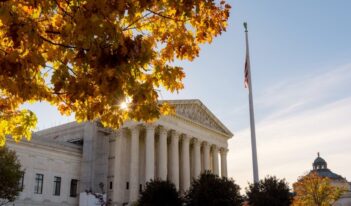
Scholar examines the role of contempt findings in ensuring agency compliance with court orders.
When a private individual or organization sues a government agency—and wins—what happens next?
For decades, legal scholars have simply assumed that the agency will “do what the court says” if it loses. But the true story appears to be more complicated.
In a recent paper, Yale Law School Professor Nicholas Parrillo examines agency compliance with court orders and finds that it is often “imperfect and fraught,” especially when courts order agencies to take some positive action. Parrillo explains that, once a judge issues an order, “it is often just the beginning of a long and delicate negotiation between the judge and the agency.” In his article, Parrillo seeks to provide the “first general assessment of how federal courts handle the federal government’s disobedience.”
Under the Administrative Procedure Act, injured persons and organizations can sue agencies in federal court. Courts have the authority to “set aside” or “compel” agency action. If an agency proves obstinate, the court can impose progressively more intrusive requirements—for example, additional deadlines and reporting obligations. If agencies fail to comply with such orders, judges have the ability to hold them and their officials—like anyone else—in contempt. A judge can also attach certain sanctions—a fine or imprisonment—to a contempt finding.
But the frequency with which these tools are actually used, and their efficacy, has been largely unexplored by researchers.
Judges face a difficult challenge. They want agencies to comply with court orders, but they also want to avoid causing an agency to violate its other legal obligations or to take “hastily-conceived action with terrible results.” A court often must rely on the agency’s cooperation, especially if a court order directs the agency to do something technically complicated, like create or amend a regulation. Judges might also be concerned that court orders can “strain a federal agency’s resources.” As a result, Parrillo explains, “judges quite often proceed cautiously, hold back, and relent.”
Parrillo searched thousands of court cases and located more than 80 opinions where, during the litigation, a court made a contempt finding against an agency or its officials. He found only 12 cases where judges tried to impose fines against an agency but observed that appellate courts “consistently blocked the fines” on appeal.
Contempt fines against federal agencies “are of uncertain legal availability, due to federal sovereign immunity,” according to Parrillo. Because the government must consent before it can be sued, and because federal law only authorizes lawsuits against agencies for non-monetary relief, scholars and judges debate whether contempt fines against agencies constitute prohibited “money damages.” Although constitutional principles—such as assignment of the “judicial power” to the federal courts—might override an agency’s immunity defense, Parrillo explains that the U.S. Supreme Court has not squarely addressed that issue.
Federal officials also face a very low risk of being sent to jail. Although imprisonment is a legally available sanction to reinforce a judicial contempt citation, several limits remain. For example, contempt is not available when “compliance is objectively impossible” or when individual agency officials lack the competence or ability to control lower-level agency employees. Parrillo found only four cases where a judge ordered jail time to a federal agency official or “credibly threatened to do so.” Just as with agency contempt fines, the higher courts “keep the lower-level sanctioning judges from going through with the sanction,” according to Parillo.
Likewise, Parrillo found just nine cases in which a judge initially imposed a fine on an individual agency official. Because of “agencies’ size and complexity,” it is often difficult to determine which official should be sanctioned. And in cases where fines are issued against officials, it is extremely likely that agencies will indemnify their employees for any contempt fines a court might levy against them. Agency fines are typically paid out of the government-wide Judgment Fund—an account managed by the U.S. Department of the Treasury that funds monetary judgments made against the federal government—rather than agency appropriations, so any compliance incentive for the agency and its officials is likely to be substantially diminished.
Parrillo concludes from his research that judges harbor a “peculiar discomfort and uncertainty when it comes to contempt against federal agencies.” For example, he points to a 1973 case, Socialist Workers Party v. Attorney General, in which the U.S. Attorney General refused to provide the names of informants for the Federal Bureau of Investigation. After the federal trial court found the Attorney General in contempt, the appellate court reversed and instructed the lower court to use “less severe, issue-based sanctions.”
Because sanctions are rare, Parrillo finds that the most common contempt findings issued by courts are those that have no sanction. These contempt findings still can exert influence over agencies even though they lack a “direct financial or physical effect on the agency or official” because “agency officials live in a community with a strong norm of compliance with court orders.” Parrillo calls this type of influence the “shaming power.”
Interestingly, Parrillo observes that when appellate courts block contempt fines against agencies, they typically “bend over backward to find” some justification other than sovereign immunity, thus avoiding general declarations about whether such sanctions are legal. To explain this phenomenon, Parrillo suggests that judges rely on agencies to willfully comply and only rarely issue sanctions in order to maintain the impression that “noncompliance is rare and deviant.”
Nevertheless, a number of limits constrain the shaming power. Issuing sanctions too readily could undermine their efficacy if officials no longer consider disobedience a serious offense. And because officials often have competing allegiances to multiple professional associations, occasionally bureaucrats may be “willing to endure the shame of contempt to preserve their credibility” in another arena, such as the scientific community.
Ultimately, Parrillo’s analysis makes clear that finding out what happens next—after an agency loses in court—may prove more complicated than many scholars thought.



